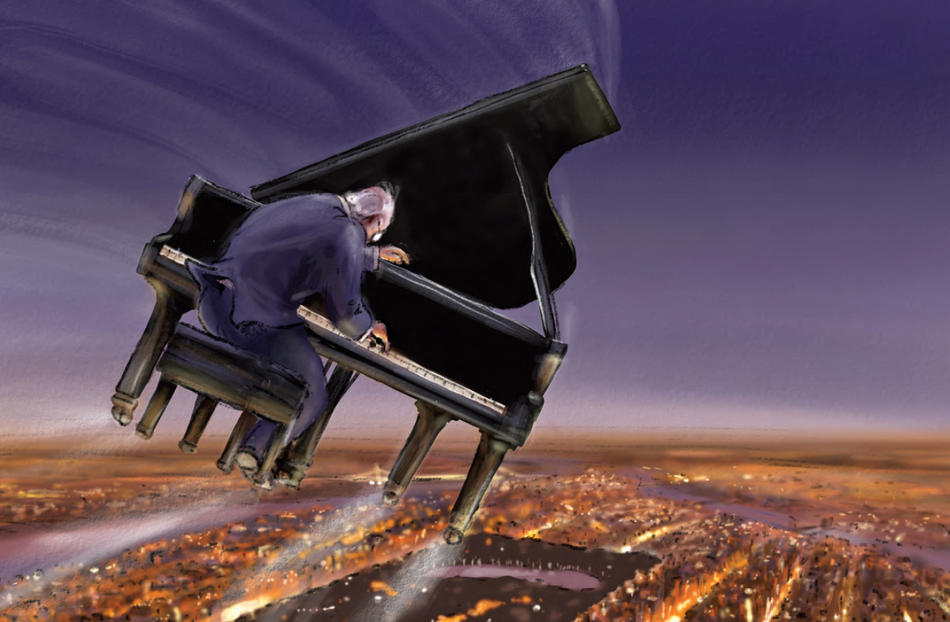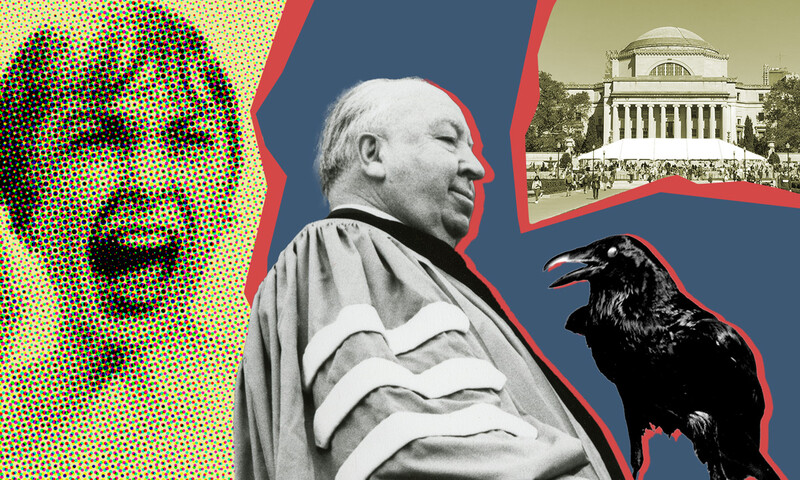Dick Hyman ’48CC, the mild-mannered jazz pianist known for his Faustian virtuosity, broad repertory, multi-style mastery, prodigious output, and vast musical knowledge, is a Yamaha artist, but that didn’t stop him from giving me a one-hour solo massage in front of two hundred people in St. Peter’s Church in Midtown the day before Thanksgiving.
I’m a Baldwin — a concert grand — a seven-footer if you must know — but if Mr. Hyman didn’t mind, I’m sure that made two of us. It’s not every day you get your ivories jitterbugged by an American master. Your pedals pumped. Your hammers struck. Your wires trembled. I’d heard a rumor that Mr. Hyman never misses a note, a claim I am now fit to substantiate. Nothing assaults one’s architecture like the vibrations produced by a clinker, and I waited the whole set, through breathless thirty-second-note runs and a left hand striding and jumping to beat the band, waited for the misstep that is bound to occur when a single piano is made to sound like three. It never did. As Mr. Hyman finished and people stood to applaud, I felt as bruised and fulfilled as the Savoy dance floor after a night with Whitey’s Lindy Hoppers.
Mr. Hyman is eighty-six years old — approaching Eubie Blake territory, as we like to say. But when you’ve been in the game for almost seventy years — when you’ve studied with Teddy Wilson, jammed with Charlie Parker and Lester Young and Zoot Sims, been musical director for Benny Goodman, served as pianist and arranger on a dozen Woody Allen movies, made more than a hundred records under your own name (including studies of Scott Joplin, Fats Waller, and Duke Ellington), imbibed the history of jazz piano and lived to tell its secrets in a book of transcriptions based on his CD and DVD package Dick Hyman’s Century of Jazz Piano — well, then, surely you’re young at heart.
In the past two years, Mr. Hyman has recorded three CDs, all duos (with his violinist daughter, Judith Hyman; the clarinetist Ken Peplowski; and the singer Heather Masse). The pianist acknowledges that this recent productivity, however impressive, marks a slowing down. “When I look back on the stuff I used to do, I can’t believe it,” he said by phone a few days after our concert, speaking in a rich subwoofer radio voice gone basso profundo from a head cold. “But there it is.” He mentioned his studio years in the 1950s and ’60s, when he’d do two or three sessions in a day and then go home and stay up all night writing an arrangement. “I don’t have that stamina anymore, I’m afraid.”
Well, I don’t know what he did have that Wednesday inside the polygonal, high-windowed sanctuary of the performing arts – fostering church on Lexington Avenue, but it was something more than stamina. Mr. Hyman, in a dark suit, white shirt, and yellow tie, hedges of white hair framing a noble pate and combed back into a wave that curled just past his collar, pale, clear eyes, and a nose as Karl Malden’s might have looked had it not been twice broken, sat before me with his supple hands light upon my enamel.
He began with “Get Happy,” a signature piece of his idol, Art Tatum. It was an admonition, a gleeful mood-setter, but halfway through it occurred to me, as I rumbled with that swift and swinging bass line, that, while full of earthly life, this was in fact a song about going across the river to that peaceful other side. Mr. Hyman followed this with “Bridge over Troubled Water” (more rivers), turning the gospel-pop hit into a fifty-foot-tall wedding cake with lots of pentatonic frosting. What next? A key chomper by Jelly Roll Morton called “Grandpa’s Spells” that rang my coils with the bells of Bourbon Street and made everyone forget about the nor’easter outside. Then a tune called “Lonely Melody,” recorded by cornetist Bix Beiderbecke with the Paul Whiteman Orchestra in 1928, when Mr. Hyman was cutting his own teeth instead of mine, and in his hands it was the opposite of lonely, for Mr. Hyman summoned all the good New Orleans ghosts from my bellows. But just when I detected a theme of mortality running through the dense harmonic jungles, the pianist turned to stride-piano master James P. Johnson’s “You’ve Got to Be Modernistic,” explaining to the audience that, in the 1920s, modernistic meant far out — softly italicizing these terms like a man outside of time. He played some augmented chords, called “crazy chords” in Johnson’s day, and showed us how Johnson inserted this then-subversive device into the parlors of 1930. Next, he introduced Thelonious Monk’s “Misterioso” with what could be his own epitaph: “It’s as mysterious as it is simple.”
After capping the set with a Tatumesque “Autumn Leaves” (autumn again: I felt a chill), and with everyone wanting more, Mr. Hyman stated that he would take a request.
“Under two conditions,” he said. “One, I have to know it.” Laughter in the sanctuary. “Two, I have to like it.” More laughter.
"'Skylahk!'" yelled a woman in the back.
Multiple voices. "'Look for the Silver Lining,'" said a man.
"'Skylahk!'"
"'Drop Me Off in Harlem,'" said a young woman near the front.
Duke Ellington. The song easily satisfied Mr. Hyman’s criteria. He sat down and swung this Baldwin chariot uptown, and as we flew together over the Manhattan spires, I thought, with a pianissimo shudder, drop me off ...
“I got a rather plaintive e-mail the other day,” Mr. Hyman said later from his home in Venice, Florida, “from a fellow who said his father was only a year younger than I, and getting to be in bad shape, and how did I do it?” The pianist laughed with a chime of self-deprecation. “On the other hand, he said his father had been forcibly retired at sixty, and didn’t know what else to do with his life. Whereas I’ve never stopped.”
“Never,” I said. “You’ve never stopped.”
“There are still things I’m exploring and trying to be more proficient at. And then, too, as you get to be — I have to admit — elderly, it’s a matter of maintaining stuff that you’ve always played. But if you don’t play it every night and every day, you find it necessary to review it. So I prepare things a little more for concerts — I think about tunes, I put them on a list, and sometimes have some music in front of me.”
“When you say you’re trying to become more proficient — do you mean at a particular style?”
“Ideally, I’d love to (and I’ve been doing it, too) introduce more counterpoint in my playing. I’d love to be able to improvise in a Bachian manner, with both hands. I haven’t arrived there yet, but I’m a little closer.”
I then said, because it had been on my mind, “I noticed you’re a Yamaha artist.”
I wasn’t trying to get personal. I was just wondering. That’s when he told me.
He said, “I was a Baldwin artist for thirty years. Then they went out of business.”
Out of business? Finito? Baldwin Pianos? It was the first I’d heard of it. My lid nearly dropped.
“I moved over to Yamaha,” Mr. Hyman said. “I like Yamahas a lot. They’re excellent performing pianos. Lightweight, which is what I prefer. They’re much more similar from piano to piano, and if you’re the kind of peripatetic player that I am, it’s comforting to know that it’s going to be pretty much what you expect.”
I trilled a laugh — Mr. Hyman’s pragmatism is part of his charm — but now I knew why I’d felt that little shiver in “Get Happy” and “Autumn Leaves.” The bell was tolling for me.
“But you were a Baldwin guy for thirty years,” I said, with a slight tremolo. “You must have loved the Baldwin, then, at some point.”
“I did like the Baldwin,” he said, with tenderness. “Very much.”
That warmed me. “Can you say what you liked about it?”
Perhaps it was I who hit a clinker. Mr. Hyman got quiet, except for the epiglottal stirrings of a faint discomposure.
“Mmm. Er. Well, I don’t know. I liked that they were available. And that the company made them available to me. A lot of these relationships have to do with mundane things like, ‘Can you provide the piano and not charge too much for it?’ In the end, it was sad to see Baldwin go under.”
I had to agree. I said, “You’ve encountered countless pianos in your career. Do you ever think about favorite pianos that you’ve had? Special ones? Is there a relationship that one has to individual instruments over a career?”
“Mmm . . . No. Not exactly.”
“Ah.” I could hardly press him further. I felt the blues coming on, a train around the bend, like the train sound in “Honky Tonk Train Blues,” by Meade Lux Lewis, which Mr. Hyman played and transcribed and explicated in Dick Hyman’s Century of Jazz Piano.
But then, as he always does, Mr. Hyman set things straight, reminding us all that the music isn’t about the dead wood, but, rather, the living flesh.
“I found out long ago,” he said, “that if you practice enough, every piano in town feels great.”



